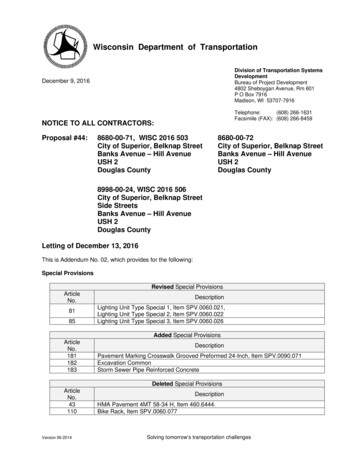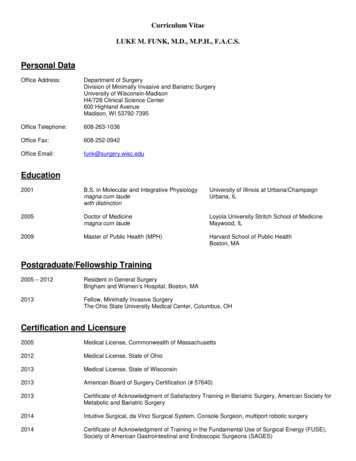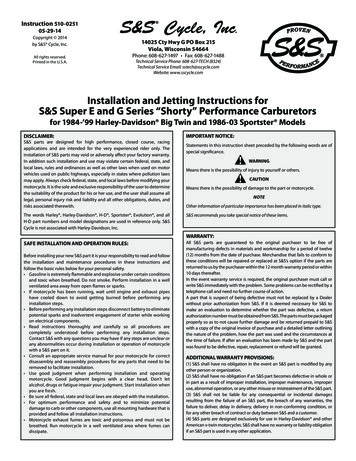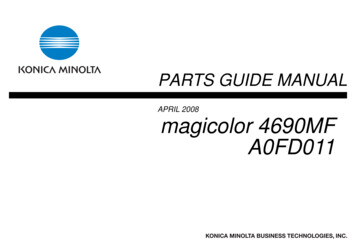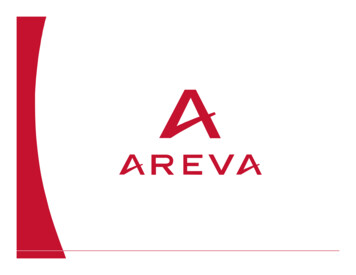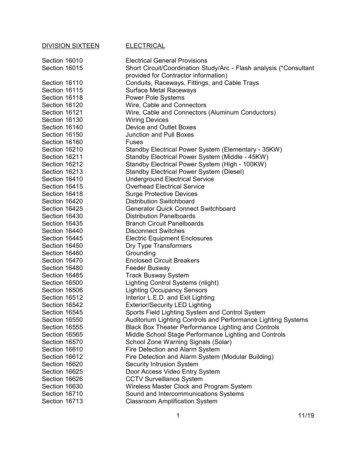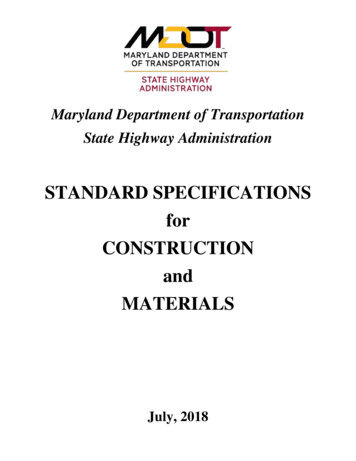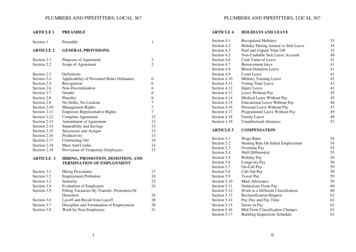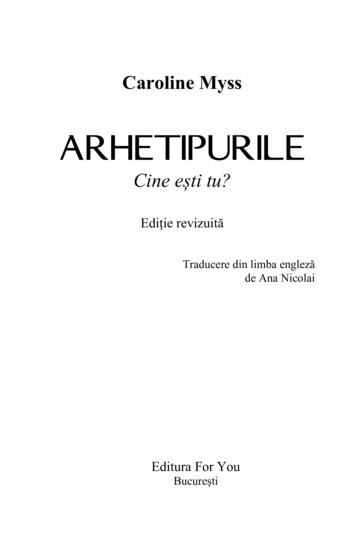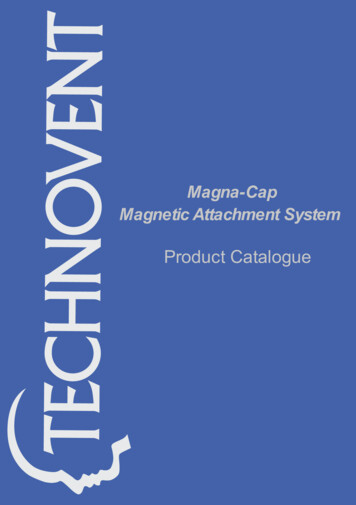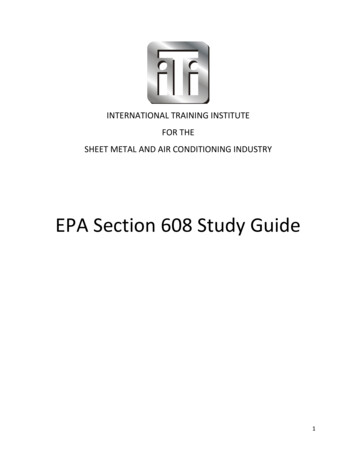
Transcription
INTERNATIONAL TRAINING INSTITUTEFOR THESHEET METAL AND AIR CONDITIONING INDUSTRYEPA Section 608 Study Guide1
TABLE OF CONTENTSINTRODUCTION3CORE SECTION5TYPE I24TYPE II28TYPE III33GLOSSARY38Temperature / Pressure Chart442
Introduction to the Section 608 Study GuideThis study guide was put together by the International Training Institute to helpprepare individuals for the EPA Section 608 certification exam. The information inthis study guide is based on the most current information available at the time ofpublishing.As a reminder, it is the technician’s responsibility to comply with any futurechanges the EPA may make.This guide will contain words in “BOLD” to help you remember key concepts andwords. At the end of each section (Core, Type I, II, & III) there will be a practicequiz. If you can answer the questions on the quiz, then you should be wellprepared to take the certification exam.Certain personal information is required on the exam. Technicians should beprepared to present: Picture identification Social security number Home addressAt the beginning of the exam, you will need to fill in your personal information andalso create a unique identification number. This number will be in Social Securitynumber format xxx‐xx‐xxxx and will be visible on the front of your certificationcard. DO NOT use your Social Security number when filling in this part.During the exam, read each test question thoroughly. Pay special attention toclarifying words like: always, never, not, sometimes, minimum, maximum, least,most, best, worst and similar words.Read every answer, even if you think the first one is correct. Many questions aremissed because not all the answer options are read. And you can always skip aquestion and come back to it.3
About the Section 608 ExamThe test is divided into 4 sections: Core, Type I, Type II, and Type IIIType I: A Type I technician primarily works on small appliances such asdomestic refrigerators, window air conditioners, PTACs and vendingmachines, etc. Type II: A Type II technician primarily works on equipment using a highpressure refrigerant such as HCFC‐22. The equipment includes residentialand lt. commercial air conditioners and heat pumps, roof top units,supermarket refrigeration and process refrigeration. Type III: A Type III technician primarily works on equipment using a lowpressure refrigerant such as HCFC‐123 or CFC‐11. These units areprimarily chillers. Universal: A candidate passing all three types is certified as UniversalEach section has 25 multiple choice questions. A technician must achieve aminimum score of 70% (18 out of 25) to pass that section of the exam. The Coresection must be passed to receive any other certification.For example: A technician could pass Core, Type I and Type III and fail Type II. Inthis case the technician would be certified as a Type I & Type III technician. Coremust be passed to receive any certification. All sections must be passed in order toachieve Universal Technician status.A technician may choose to take Core plus any combination of Type I, Type II orType III. It is not required to take all four sections on the exam.Tests are closed‐book tests. The only outside materials allowed are atemperature/pressure chart and a calculator. The temperature/pressure chartand calculator are both available onscreen, on the online version of the exam.Otherwise, you may remove the chart at the end of this study guide for the exam.4
COREIn this section we will cover general knowledge such as: Ozone depletion Clean Air Act and the Montreal Protocol Section 608 regulations Substitute refrigerants and oils Refrigeration Three R’s Recovery techniques Dehydration evacuation Safety ShippingMany consider the Core Section to be the most important section as Core isrequired to achieve any other certification type. And also because theinformation found in the Core Section, comes up again in other sections.5
Ozone Depletion:Ozone is a naturally occurring gas molecule that is made up of three oxygenatoms (O3). This gas occurs both in the Earth’s upper atmosphere and at groundlevel. At ground level, ozone is considered “bad” and is a pollutant that causessignificant health risks as well as damaging vegetation.The ozone that occurs in the upper atmosphere or stratosphere is considered“good” ozone. This “good” ozone in the stratosphere is a layer that extendsabout 6 to 30 miles above earth and creates a protective shield for Earth fromthe sun’s harmful ultraviolet (UV) rays. Depletion of ozone allows more of thesun’s harmful UV rays to reach the earth resulting in the following problems: Increased temperature of the earth Increased cases of skin cancer Increased numbers of cataracts in the eyes Increased ground level ozone Crop and vegetation loss Reduced marine lifeWhile the total amount of ozone in the stratosphere varies by location, time andseason, the effect of ozone depletion is a global problem.Destruction Process of OzoneOzone can be destroyed by chlorine and bromine atoms emitted into theatmosphere. When a chlorine atom meets with an ozone molecule, it takes anoxygen atom from the ozone molecule. The ozone molecule (O3) changes to anoxygen molecule (O2), while the chlorine atom changes to a compound calledchlorine monoxide (ClO).6
When chlorine monoxide meets ozone, it releases its oxygen atom and formstwo O2 oxygen molecules, leaving the chlorine molecule free to attack anotherozone molecule and repeat the process. It is estimated that a single chlorine atomcan destroy 100,000 ozone molecules.There has been a great deal of controversy over the subject of Ozone depletion.Some believe that the Chlorine found in the stratosphere comes from naturalsources such as volcanic eruptions. However, air samples taken over eruptingvolcanoes show that volcanoes contribute only a small quantity of Chlorine ascompared to CFC's.In addition, the rise in the amount of Chlorine measured in the stratosphere overthe past two decades matches the rise in the amount of Fluorine, which hasdifferent natural sources than Chlorine, over the same period. Also, the rise in theamount of Chlorine measured in the stratosphere over the past twenty years,matches the rise in CFC emissions over the same period.Unlike other Chlorine compounds and naturally occurring chlorine, the chlorinein CFC's will neither dissolve in water nor break down into compounds thatdissolve in water, so they do not rain out of the atmosphere.Despite being heavier than air, CFCs reach the stratosphere through wind motionsthat carry them upwards.Ozone depletion potential (ODP) is the measurement of the ability of CFCs andHCFCs to destroy the ozone. CFCs have the highest ODP, followed by HCFCs. HFCsdo not contain any chlorine and therefore do not have an ODPGasCFCHCFCExampleR‐11, R‐12, R‐500R‐22, R‐123ElementsChlorine, Fluorine, CarbonHydrogen, Chlorine, Fluorine, CarbonODPHigherLowerHFCR‐134aHydrogen, Fluorine, CarbonNone7
CLEAN AIR ACT:The United States Environmental Protection Agency (EPA) regulates section 608of the Federal Clean Air Act.Failure to comply could cost you and your company as much as 27,500* perday, per violation and there is a bounty of up to 10,000, to lure your competitors,customers and fellow workers to turn you in.Service technicians who violate Clean Air Act provisions may be fined, lose theircertification, and may be required to appear in Federal court.The EPA may require technicians to demonstrate the ability to properly performrefrigerant recovery/recycling procedures. Failing to demonstrate these skills canresult in revocation of certification.It is a violation of Section 608 to: Falsify or fail to keep required records; Fail to reach required evacuation rates prior to opening or disposing ofappliances; Knowingly release (vent) CFC's, HCFC's or HFC’s while repairing appliances,with the exception of de‐minimus releases; Service, maintain, or dispose of appliances designed to contain refrigerantswithout being appropriately certified as of November 14, 1994. (It is theresponsibility of the final person in the disposal chain to ensure thatrefrigerant has been removed from appliances before scrapping.) Vent CFC's or HCFC's since July 1, 1992; Vent HFC's since November 15, 1995; Fail to recover CFC's, HCFC's or HFC’s before opening or disposing of anappliance; Fail to have an EPA approved recovery device, equipped with low lossfittings, and register the device with the EPA; Add nitrogen to a fully charged system, for the purpose of leak detection,and thereby cause a release of the mixture; Dispose of a disposable cylinder without first recovering any remainingrefrigerant (to 0 psig.) and then rendering the cylinder useless, thenrecycling the metal;In addition, some state and local government regulations may contain regulationsthat are as strict as or stricter than Section 608.8
Montreal Protocol:The Montreal Protocol is an international agreement (Treaty) regulating theproduction and use of CFCs, HCFC’s, halons, methyl chloroform and carbontetrachloride entered into force in mid 1989.Known as The Montreal Protocol, this landmark agreement initially required aproduction and consumption freeze.The Montreal Protocol called for a stepwise reduction and eventual productionphase out of various Ozone Depleting Substances in developed countries. CFC'swere phased‐out of production on December 31, 1995.HCFC refrigerants are scheduled of phase out in the future. When virgin suppliesof CFC's are depleted, future supplies will come from recovered, recycled, orreclaimed refrigerants.Venting:Since November 15, 1995, knowingly venting any refrigerant is a violation ofthe CAA. This includes CFC & HCFCs, and/or CFC & HCFCs refrigerant substitutes,such as 134‐A or 410‐A.Only the de minimis release is allowed during service, routine maintenance orrepair, which refers to the small amounts of refrigerants emitted unintentionallyduring good faith efforts to recover refrigerants, during the normal course ofappliance operation or during the connection/disconnection to charge or servicean appliance.Nitrogen that is used for holding charges or as leak test gases may be released;however, nitrogen may not be added to a fully charged system for the purposefor leak detection and then released.All CFCs and HCFCs must be recovered before opening a system for service ordisposing of appliances.9
Cylinder & Appliance Disposal:Before disposing of any appliance containing a CFC or HCFC refrigerant, therefrigerant must be recovered. The person responsible for ensuring thatrefrigerants have been removed from household refrigerators before they aredisposed of is the final person in the disposal chain.All refrigerants in disposable containers have been recovered (0 psig or lower)and rendered useless before recycling the cylinder.SALES RESTRICTION:As of November 14, 1994, the sale of CFC and HCFC refrigerants is restricted tocertified technicians. Only technicians certified under Clean Air Act Section 609(Motor Vehicle Air Conditioning) are allowed to purchase refrigerants incontainers smaller than 20 lbs.Refrigerant Oils:Due to the change in refrigerant use, you may encounter new refrigerants, oldrefrigerants, and blends of older refrigerants as well as different oils in the field.Mineral, or petroleum, oils include paraffin‐based oils, napthene‐based oils,and mixed oils (a combination of napthene‐based and paraffin‐based oils).Synthetic oils include silicate ester, silicone, neo‐pentyl ester, dibasic acid ester,polyglycols such as polyalkylglycol (PAG), alkyl benzene (AB), and polyolyester(POE). Synthetic oils must be stored in metal containers. The ester oils aregenerally used with alternative refrigerants and are typically compatible withmineral oils and existing system components.10
Refrigerant oil must be miscible (able to be mixed) at low temperatures; it mustlubricate even when it is diluted; it must have electrical insulating properties; itmust maintain its stability; and it must provide a pressure seal.Oil Types:Oil TypeMineral OilAlkylbenzenePolyolesterPolyalkylenel lPolyalphaolefinAbbreviationMOABPOEPAGPAOUseCFC refrigerant systemsR‐22 and other refrigerant systemsHFC refrigerant systemsR‐134a automotive systemsR‐717 (ammonia) refrigeration systemsOil Properties:All refrigerant oils are hygroscopic (meaning they attract moisture). Allrefrigerant oils have certain properties in common. The viscosity of an oil refers toits thickness, while the density of the oil refers to the composition of the oil at agiven viscosity. An oil’s stability is its ability to lubricate without chemicalbreakdown; its solubility refers to its miscibility with various refrigerants.(Solubility of air refers to the air and moisture entrainment capacity of an oil.)Miscibility refers to the ability of an oil to be mixed; low temperature miscibilityrefers to the oil’s ability to remain mixed (in other words, not separate) at a lowtemperatureFoaming refers to the tendency of the oil to foam when it is subjected topressure changes. Foaming will reduce the oil’s ability to lubricate. Thedielectric strength of an oil is the threshold at which the oil conductselectricity. An oil’s oxidation value is its ability to resist sludge accumulation. Itsboundary film‐forming ability is its ability to separate high pressure and lowpressure.11
Substitute RefrigerantsThere is no “drop‐in” replacement gas for R‐12 systems; all replacementrefrigerants require additional retrofit procedures. In particular, the newrefrigerants are incompatible with the oils and lubricants used in R‐12 systemsand therefore, oils must be checked and changed out as part of the retrofitprocedure.R‐134A (also called HFC‐134a) is the leading replacement option for retrofittingR‐12 systems. The oils used in most R‐134A systems are ester based oils andester based oils do not mix with other oils. Leak check an R‐134A system usingpressurized nitrogen.Temperature glide is the difference in temperature that occurs when arefrigerant evaporates or condenses (changing from vapor to liquid or liquid tovapor) under constant pressure. This means the temperature in the evaporatorand the condenser is not constant.Temperature glide can also be understood as the difference between the dewpoint and the bubble point. The dew point occurs when the saturationtemperature in the evaporator causes the refrigerant to change from a liquid toa vapor. The bubble point occurs when the saturation point in the condenserchanges the refrigerant from a vapor to a liquid.One problem with blended refrigerants is that since the different refrigerants inthe blend have different vapor pressures, they leak from systems at uneven rates.Charging a blended refrigerant should be done as a liquid.Ternary blends are three‐part mixtures. They are common types of refrigerantblends that contain HCFCs. Ternary blends are used with a synthetic alkylbenzenelubricant. Alkylbenzene lubricant is hygroscopic, meaning that it absorbs (takeson) moisture.12
A zeotropic (or non‐azeotropic) refrigerant is a blend of components thatchange their composition and saturation temperatures as they evaporate orcondense at constant pressure. In other words, the blend boils out at differenttemperatures (exhibits temperature glide) but at the same pressure. Zeotropesare blends of two or more refrigerants that retain the characteristics of eachrefrigerant. Because the components have different boiling points, they can leakat an uneven rate. Zeotropic mixtures should be charged as a liquidAn azeotropic refrigerant contains fluids that boil out at the same temperatures(do not exhibit temperature glide) and act as a single refrigerant. Azeotropes areblends of two or more compounds that act like a single compound. Azeotropicrefrigerants can be charged as a vapor or a liquidA blended refrigerant, or near‐azeotropic mixture (sometimes referred to asNARM) contains refrigerants with different boiling points, but that act as onesubstance when they are in either a liquid or a vapor state. Near‐azeotropicmixtures exhibit temperature glide when they change from vapor to liquid, orvice versa. However, the temperature glide is less than 10ºF. Near‐azeotropicmixtures can exhibit fractionation (when the mixture’s composition changes as aresult of vapor charging) and may affect the leak ratio. Near‐azeotropic mixturesshould be charged as a liquid.13
Gauge Manifold SetGAUGE MANIFOLD SET:One of the most important tools to the HVACR technician is the gauge manifoldset. The compound gauge (blue) and the high pressure gauge (red) are connectedto the manifold, and the manifold is then connected by hoses to access ports tomeasure system pressures.The compound gauge measures low pressure (psig) and vacuum (inches Hg.).The high pressure gauge measures high side (discharge) pressure.The manifold is also equipped with a center port, (usually a yellow hose), that canbe connected to a recovery device, evacuation vacuum pump, or charging device.EPA regulations require that hoses be equipped with low loss fittings that willminimize refrigerant loss when hoses are disconnected.14
The Refrigeration Cycle:VAPOR / COMPRESSION REFRIGERATION CYCLE:In the vapor / compression refrigeration cycle, liquid refrigerant at a highpressure is delivered to a metering device, (11). The metering device causes areduction in pressure, and therefore a reduction in saturation temperature.The refrigerant then travels to the evaporator, (1,2,3,4,5). Heat is absorbed in theevaporator and causes the refrigerant to boil from liquid to vapor.At the outlet of the evaporator, (6), the refrigerant is now a low temperature, lowpressure vapor.The refrigerant vapor then travels to the inlet of the compressor, (7). Therefrigerant vapor is then compressed and moves to the condenser, (8,9). Therefrigerant is now a high temperature, high pressure vapor.As the refrigerant expels heat, the refrigerant condenses to a liquid. At thecondenser outlet, (10), the refrigerant is a high pressure liquid. The high pressureliquid refrigerant is delivered to the metering device, (11), and the sequencebegins again.15
Some accessories that are not shown in the basic diagram are the receiver andaccumulator. Use of these components depends on system design and / or on thetype of metering device used. A system that uses a thermostaticexpansion valve is usually equipped with a receiver, which would be located in theliquid line directly following the condenser. A system that uses a capillary tube orfixed bore metering device is usually equipped with an accumulator, which wouldbe located in the suction line directly following the evaporator.Service and Maintenance:In order to limit the potential of accidental refrigerant emissions, it is important tofollow procedures and make sure the refrigeration system is in good operatingorder. This includes making sure that equipment used is approved by the EPA,checking for leaks, repairing leaks and making sure that all fittings are tight duringservice and recovery.Leak detection in a refrigeration system is important to keep the system runningwell and to prevent refrigerant escaping into the atmosphere. When checking forsmall leaks, using a halide torch is the most effective method. You can alsoevacuate the system and pull a vacuum on it. If the system will not hold a vacuum,you have a leak. If the system has completely lost its charge and you want to testit for a leak, charge it with dry nitrogen for testing and never use refrigerantgases. Nitrogen is environmentally friendly and is safe to handle.If you suspect a major leak or major component failure, an oil sample should betaken. If there are contaminants in the oil, the system will need to be flushed.In the event of a burnout of the compressor:1.2.3.Triple‐evacuate the system.Install a permanent filter‐drier.Conduct a deep vacuum before recharging16
The Three R’s:The three R’s of refrigeration are: recover, recycle, and reclaim.Recover: is to remove refrigerant in any condition from a system and store it inan external container without necessarily testing or processing it in any way.Recycle: is to clean refrigerant for immediate reuse by separating the oil fromthe refrigerant and removing moisture and acidity from the refrigerant by use ofproducts like filter driers.Reclaim: is to process refrigerant to the level of new product specifications asdetermined by chemical analysis. Reclaimed refrigerant must meet the standardset forth in ARI 700 before it can be resoldRECOVERY DEVICES:Refrigerant Recovery and/or Recycling equipment manufactured after November15, 1993, must be certified and labeled by an EPA approved equipment testingorganization to meet EPA standards.There are two basic types of recovery devices.1) “System‐dependent” which captures refrigerant with the assistance ofcomponents in the appliance from which refrigerant is being recovered.2) "Self‐contained” which has its own means to draw the refrigerant out of theappliance.17
Recovery Techniques:All refrigerant recovery and/or recycling equipment now manufactured mustbe certified and labeled by an EPA‐approved equipment testing organizationto meet EPA standards. This covers all air conditioning and refrigerationequipment containing CFC and HCFCs.There are two basic types of recovery devices. System dependent devicescapture refrigerant with the assistance of the compressor and/or the pressure ofthe refrigerant in the appliance from which refrigerant is being recovered. Self‐contained devices have independent means to draw the refrigerant out of theappliance.The EPA requires a service aperture or process stub on all appliances that use aClass I or Class II refrigerant in order to make it easier to recover refrigerant.Schrader valves (which look like bicycle tire air valves) are common on bothrefrigerant systems and recovery equipment. When using Schrader valves, it iscritical to: Check the valve core for bends and cracks Replace damaged Schrader cores to prevent leaks Cap the Schrader ports when not being used to prevent leaksDue to the increased charges for recovering refrigerants, consumers havecomplained about paying for the process. In order to handle thesecomplaints, let the consumer know that: Recovery is the law. Recovery is necessary to protect human health and the environment. All professional service personnel are duty bound to follow the law andprotect the environment.18
When recovering refrigerants, only put one type of a refrigerant in a tank and donot mix different refrigerant types into one tank. Mixed refrigerants in the sametank may be impossible to reclaim. When servicing a system that already has a mixof two or more refrigerants, the mixed refrigerants must be recovered into aseparate tank.The longer it takes to recover the refrigerants, the higher chance of emissions ofthe refrigerants to the atmosphere. The following factors affect the time it takes torecover refrigerant. Size of refrigeration system and recovery equipment. The bigger thesystem, the longer the recovery process. The bigger capacity of therecovery equipment, the faster the recovery. Size of suction hose. The longer the suction hose and the smaller indiameter it is, the higher the pressure drop in the system and the longer itwill take to recover refrigerants. Temperatures. The colder the ambient temperature, the longer therecovery process. If the refrigerant system is warmer than the recoverycylinder, the recovery process will go faster due to a higher pressure in therefrigerant system and a lower pressure in the recovery cylinder.19
Recovery Cylinders:Recovery cylinders differ in many ways from disposable cylinders. Disposablecylinders are used only with virgin refrigerant and may NEVER be used forrecovery.Recovery cylinders are specifically designed to be refilled. Recovery cylindershave 2 ports, one liquid and one vapor.Care must be taken not to overfill or heat these cylinders, thereby causing anexplosion.The EPA requires that a refillable refrigerant cylinder MUST NOT BE FILLEDABOVE 80% of its capacity by weight, and that the safe filling level can becontrolled by either mechanical float devices, electronic shut off devices(thermistors), or weight.Refillable cylinders must be hydrostatically tested and date stamped every 5years.Refillable cylinders used for transporting recovered pressurized refrigerant mustbe DOT (Department of Transportation) approved.Approved refrigerant recovery cylinders can easily be identified by their colors,YELLOW TOPS AND GRAY BODIES.All refrigerant recovery cylinders should be inspected for RUST. If they show signsof rust or appear to not be secure they should be reduced to 0 psig and discarded.20
Dehydration / Evacuation:The purpose of dehydrating a refrigeration system is to remove water and watervapor. The presence of moisture in an operating refrigeration system can createhighly corrosive and toxic acids. The recommended method for dehydration isevacuation. Before evacuating a system, it is important to first recover allrefrigerant and attain the mandated vacuum level. The factors that affect thespeed and efficiency of evacuation are: Size of equipment being evacuated. The larger the equipment, thelonger it will take to evacuate. Ambient temperature. The warmer the temperature, the faster it willevacuate. You may heat the refrigeration system to decrease theevacuation time. Amount of moisture in the system. The more moisture in the system,the longer it will take to evacuate. Size (capacity) of vacuum pump and suction line. The bigger thecapacity of the vacuum pump, the shorter the time.The piping connection to the pump should be as short in length as possibleand as wide in diameter as possible. Vacuum lines (hoses) should be equal toor larger than the pump intake connection.For the most accurate readings during evacuation, the vacuum gauge (MicronGauge) should be located as far as possible from the vacuum pump. Measuringthe vacuum of a system should be done with the system isolated and vacuumpump turned off. If the system will not hold a vacuum, then it has a leak.Dehydration is considered complete when the vacuum gauge shows that havereached and held the required finished vacuum. It is not possible to over‐evacuatea system.21
Safety:The EPA is not only concerned with the prevention of refrigerant venting, but isalso concerned with the technicians overall safety. When handling and fillingrefrigerant cylinders, or operating recovery or recycling equipment, youshould wear safety glasses, protective gloves, and follow all equipmentmanufacturers safety precautions.When pressurizing a system with nitrogen, you should always charge through apressure regulator and insert a relief valve in the downstream line from thepressure regulator. Relief valves MUST NOT be installed in series. If corrosionbuild‐up is found within the body of a relief valve, the valve MUST be replaced.When leak checking a system, NEVER pressurize the system with oxygen orcompressed air. When mixed with refrigerants, oxygen or compressed air can causean explosion. To determine the safe pressure for leak testing, check the data platefor the low‐side test pressure value.When using recovery cylinders and equipment with Schrader valves, it is critical toinspect the Schrader valve core for leaks, bends and breakage. Replace damagedvalve cores to prevent leakage, and always cap Schrader ports to prevent accidentaldepression of the valve core. NEVER heat a refrigerant cylinder with an open flame.Do not cut or braze refrigerant lines on a charged unit.In the event of a “large” release of refrigerant in a confined area, Self ContainedBreathing Apparatus (SCBA) is required.If a large leak of refrigerant occurs in an enclosed area, and SCBA is not available,IMMEDIATELY VACATE AND VENTILATE the area. In large quantities, refrigerants cancause suffocation because they are heavier than air and displaceoxygen. Inhaling refrigerant vapors or mist may cause heart irregularities,unconsciousness, and oxygen deprivation leading to death (asphyxia).NEVER expose R‐12 or R‐22 to open flames or glowing hot metal surfaces. At hightemperatures, R‐12 and R‐22 decompose to form Hydrochloric acid, Hydrofluoricacid, and Phosgene gas.Always review the material safety data sheets, when working with any solvents,chemicals, or refrigerants.22
Refrigerant safety is addressed in ASHRAE Standard 15‐1994, Safety Code forMechanical Refrigeration. This standard specifies an oxygen sensor and alarm forA1 refrigerants, and a refrigerant detector for all other refrigerants, as well asspecifying ventilation requirements, but may not prevent hazardousaccumulations.Refrigerants are classified by a letter and a number; the letter indicates its toxicityand the number indicates its flammability. Refrigerants in the “A” category have alower toxicity, while refrigerants in the “B” category have a higher toxicity.Similarly, refrigerants in the “1” category have no flame propagation (minimalflammability), while refrigerants in the “3” category have high flammability.Refrigerant mixtures are classified based on worst‐case fractionation.ASHRAE ClassificationHigher FlammabilityLower FlammabilityNo Flame PropagationLower ToxicityA3A2A1Higher ToxicityB3B2B1Shipping:Before shipping any used refrigerant cylinders, check that the cylinder meets DOTstandards, complete the shipping paperwork including the number of cylinders ofeach refrigerant, and properly label the cylinder with the type and amount ofrefrigerant.Cylinders should be transported in an upright position. Each cylinder must bemarked with a DOT classification tag indicating it is a “2.2 non‐flammable gas”.Some states may require special shipping procedures to be followed based on theirclassification of used refrigerants. Check with the DOT in your state.23
TYPE IRecovery Requirements:According to the EPA, a small a
Introduction to the Section 608 Study Guide This study guide was put together by the International Training Institute to help prepare individuals for the EPA Section 608 certification exam. The information in this study guide is based on the most
